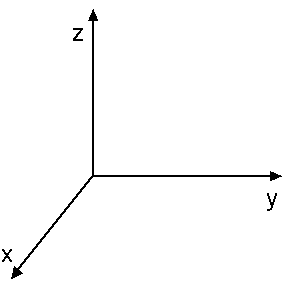

Scalar Product
of Two Vectors

By definition, the scalar product, also known as the "dot product",
of two vectors A and B is
A
B = A B cos
A
B = A B cos
This "dot product" is commutative,
A B = B
A
This "dot product" is distributative,
A (B + C) = A
B + A
C
A = Ax i + Ay j + Azk
B = Bx i + By j + Bzk
A B = (Ax i + Ay j + Azk)
(Bx i + By j + Bzk)
= Ax Bx( i
i) + Ax By( i
j) + Ax Bz( i
k) +
+ Ay Bx( j
i) + Ay By( j
j) + Ay Bz( j
k) +
+ Az Bx( k
i) + Az By( k
j) + Az Bz( k
k)
What are these dot products of the unit vectors, i, j, and k?

From our initial definition of the scalar product, A
B = A B cos
, we have
i i = 1
1 cos 0 = 1
i j = 1
1 cos 90o = 0
i k = 1
1 cos 90o = 0
j i = 1
1 cos 90o = 0
j j = 1
1 cos 0 = 1
j k = 1
1 cos 90o = 0
k i = 1
1 cos 90o = 0
k j = 1
1 cos 90o = 0
k k = 1
1 cos 0 = 1
i i = 1
1 cos 0 = 1
i j = 1
1 cos 90o = 0
i k = 1
1 cos 90o = 0
j i = 1
1 cos 90o = 0
j j = 1
1 cos 0 = 1
j k = 1
1 cos 90o = 0
k i = 1
1 cos 90o = 0
k j = 1
1 cos 90o = 0
k k = 1
1 cos 0 = 1
That means
A B = (Ax i + Ay j + Azk)
(Bx i + By j + Bzk)
= Ax Bx( i
i) + Ax By( i
j) + Ax Bz( i
k) +
+ Ay Bx( j
i) + Ay By( j
j) + Ay Bz( j
k) +
+ Az Bx( k
i) + Az By( k
j) + Az Bz( k
k)
A
B = Ax Bx( 1) + Ax By( 0) + Ax Bz( 0) +
+ Ay Bx( 0) + Ay By( 1) + Ay Bz( 0) +
+ Az Bx( 0) + Az By( 0) + Az Bz( 1)
= Ax Bx + Ay By + Az Bz
That is,
A B = Ax Bx + Ay By + Az Bz
The definition of the scalar product,A B = A B cos
means that work is the scalar product of the Force and the displacement,
W = F s
Sometimes it will be easier to evaluate this as
W = F s = F s cos
and sometimes it will be easier to evaluate this as
W = F s = Fx sx + Fy sy + Fz sz
W = F
s = Fx x + Fy y + Fz z
Constant Force Varying Force Return to ToC, Ch7, Work and Energy (c) Doug Davis, 2001; all rights reserved